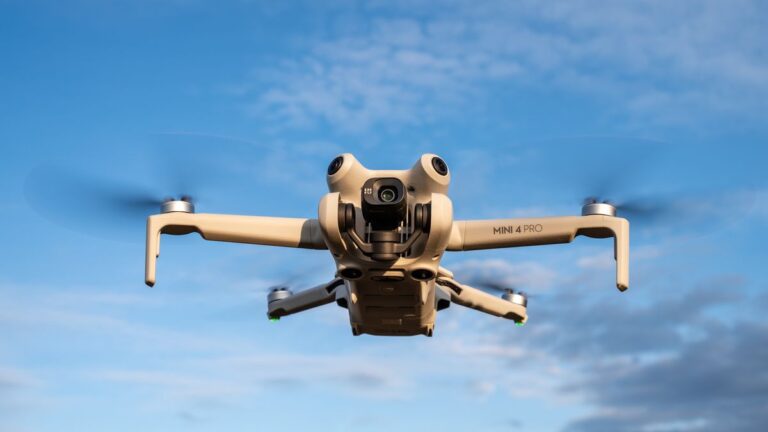
[ad_1]
One of DJI’s more unexpected launches late in 2023, considering the DJI Mini 3 Pro was only launched in spring 2022, was the DJI Mini 4 Pro, which has become the best sub-250g drone available. The new features are great, albeit not a massive upgrade on the Mini 3 Pro, but it’s safe to say that the Mini 4 Pro is one of the best drones available and one of the best camera drones.
Key Specs
Weight: 8.8 oz / 249 g
Dimensions: 5.8×3.7×2.5 in / 148×94×64 mm folded / 11.7×14.7×4.0 / 298×373×101 mm unfolded
Battery: 2590 mAh / up to 34 minutes flight time
Charger type: Type-C to Type-C PD Cable / Three Battery Charging Hub
Modes: Cine, Normal, Sport
Video transmission range: Up to 12.4 miles / 20 km (FCC) / up to 6.2 miles / 10 km (CE/SRRC/MIC)
Video resolution: 4K, 1080p
Frame rates: 4K up to 100 fps / 1080p up to 200 fps
The DJI Mini 4 Pro delivers several features typically seen in higher-end DJI models such as the Mavic 3 series drones and the DJI Air 3. These include Omnidirectional Obstacle Avoidance, improved subject tracking, advanced Return to Home and several upgrades in the video capture department. The image sensor and the camera are the same as the Mini 3 / Mini 3 Pro so image quality is similar, although image processing is claimed to have been improved.
The DJI Mini 4 Pro is available with two controller options with the DJI Mini 4 Pro (DJI RC-N2) kit costing $759 / £689 and the DJI Mini 4 Pro (DJI RC 2) kit costing $959 / £869. A Fly More Bundle is also available for the Mini 4 Pro (DJI RC 2) and this costs $1099 / £1149. This puts the price of the Mini 4 Pro at almost the same amount as the launch price of the Mini 3 Pro last year, so with this new model, you’re certainly getting more bang for your buck.
DJI Mini 4 Pro review
DJI Mini 4 Pro review: Design
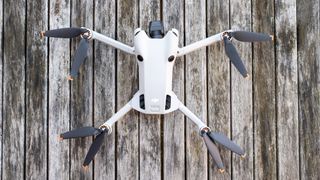
- Sub-249g model with a folding design
- Palm-size when folded
- Two controller options
One thing you’ll immediately notice about the Mini 4 Pro is how similar it looks to the Mini 3 Pro, except for the Omnidirectional Collision Avoidance sensors on the top of the drone and the Auxiliary Light on the bottom. It’s a design that works well and takes the Mini 4 Pro from a palm-size 5.8 x 3.7 x 2.5-in (148 × 94 × 64 mm) when folded to 11.7 x 14.7 x 4.0-in (298 × 373 ×101 mm) when unfolded, with a weight of 8.8 oz (249g) including the standard Intelligent Flight Battery.
The standard 2590 mAh Intelligent Flight Battery is advertised as providing up to 34 minutes of flight time, which in real-world flying conditions comes in at 20-25 minutes before Return to Home is initiated when the battery reaches 20% capacity. There is also an Intelligent Flight Battery Plus that’s available separately and is claimed to increase flight times to up to 46 minutes, but this takes the weight of the drone above 250g and this battery option isn’t available in Europe.
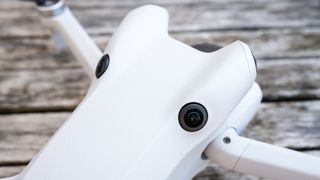
As is often the case with DJI consumer drones, there are two controller options available to meet both the needs of pilots and, importantly, their budgets. The DJI RC-N2 is the less expensive standard option that has no screen and instead has a telescopic phone holder at the top that can also accommodate the phone cable when not in use. For this controller, you need to connect your smartphone to run the DJI Fly app.
The more expensive controller is the DJI RC 2 which features a 5.5-inch screen with a 700-nit brightness. It doesn’t cost a huge amount more than the DJI RC-N2 option, so it’s well worth considering. This controller doesn’t have a network connection like your phone, so to access maps you can download offline maps to the controller or connect it to your phone’s WiFi. The latter option provides a location map but WiFi is disconnected during flight.
DJI Mini 4 Pro review: Functionality
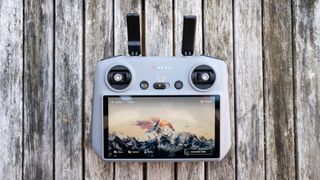
- Omnidirectional Obstacle Sensing
- Smart Return to Home
- Improved subject tracking
The Mini 4 Pro is a great performer overall and flies almost identically to the Mini 3 Pro, except for some of the new features that we’ll discuss in a moment. It’s very much a DJI drone in terms of functionality and reliability, so it’s incredibly easy to fly even for beginners thanks to its GPS positioning, which holds the drone in position without drifting, and Cine, Normal and Sport flight modes providing different levels of speed and functionality depending on what you’re shooting.
The arrival of Omnidirectional Vision Sensing is a vast improvement on the collision avoidance seen with the Mini 3 Pro, although the latter is still a great performer. This feature uses four fisheye vision sensors, downward binocular vision sensors and a 3D ToF sensor to help avoid crashes in complex environments, and it works exceptionally well. However, it can sometimes cause flight movements that would ruin smooth cinematic video.
Omnidirectional Vision Sensing, when working alongside Advanced Pilot Assistance Systems (APAS), does help you to push the drone further to capture more dynamic video. Although the Bypass/Nifty mode allows you to fly in the most complex environments with confidence, you still have to take great care and even the DJI Fly app warns of this.
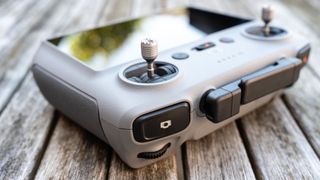
The Omnidirectional Vision Sensing, which ultimately brings the Mini 4 Pro in line with higher-end DJI models such as the DJI Air 3 and Mavic 3 models, also paves the way for some great features that rely on this technology. First off, there’s ActiveTrack 360° subject tracking, which provides improved and safer subject tracking features and works exceptionally well. Then, there’s Advanced Return to Home, which takes advantage of Omnidirectional Obstacle Avoidance for a safer and more reliable Return to Home by calculating the most efficient route back to the take-off point.
There are also the features that you might consider standard, including Hyperlapse, which is incredibly easy to use and effective, MasterShots, which is kind of pointless since it’s Quickshots rolled into one maneuver, Quickshots automated flight patterns for capturing cinematic footage at the touch of a button, and then there’s the Digital Zoom. Digital Zoom works well for getting closer to distant subjects, but since it crops into the pixels, there’s always a trade-off in terms of zoom factor versus the reduction of image quality as a result of using the feature.
DJI Mini 4 Pro review: Performance
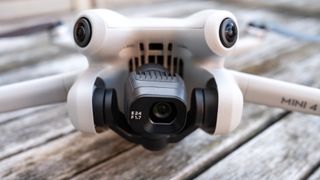
- 12/48MP 1/1.3-inch sensor
- 24mm f/1.7 camera
- Improved video capture
The image quality produced by the Mini 4 Pro is excellent, especially for such a compact drone, since it uses the same 12/48MP 1/1.3-inch sensor with large 2.4μm pixels as the Mini 3 Pro. This is housed within a camera offering an equivalent focal length of 24mm with a fixed f/1.7 aperture that can be rotated 90 degrees for portrait format shooting of both photos and videos. The gimbal can also be tilted between -90 degrees and 60 degrees to provide options for creative shooting.
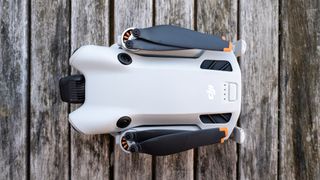
Photos are typically sharpest in the center of the frame with a small amount of fall-off towards the edges, although for video this isn’t noticeable. High ISO handling, just like the Mini 3 Pro, is excellent throughout the ISO range, which differs depending on the mode you’re shooting in. The full ISO range is 100-6400, with Night Mode taking it as far as ISO 100-12,800. Night Mode is a new feature that optimizes noise handling when shooting video in low light.
The new features are claimed to focus on image processing, which appears to be software- rather than hardware-based. But while this may be functionality that could have been delivered to the Mini 3 Pro in a firmware update, the improvements are useful, and when paired with the Obstacle Avoidance upgrades make the Mini 4 Pro the better drone of the two.
As always, photos can be captured in RAW and JPEG formats with several shooting modes available, including Automatic Exposure Bracketing, Pano and 48MP photo which splits the large pixels into four to create higher resolution photos, among other modes. And SmartPhoto is claimed to improve on the previous generation HDR capture with the HDR shooting option.
Video is where the most upgrades have occurred, and in this area the Mini 4 Pro ties in much more closely to the Air 3 and Mavic 3 models with the introduction of the flat 10-bit D-Log M color profile, which increases dynamic range and captures more colors but requires additional processing in video editing software. There is still the 8-bit Normal profile, which provides video that’s usable straight out of the camera, plus there’s HLG (HDR), which produces out-of-camera usable video with a higher dynamic range. 4K capture is now possible up to 100 fps for slow motion video alongside 1080p at up to 200 fps. And for advanced users, you can now also control the sharpness and noise reduction in video.
DJI Mini 4 Pro review: Cost
The DJI Mini 4 Pro is available with two controller options and in a Fly More Bundle for almost the same price as the DJI Mini 3 Pro at launch. The DJI Mini 4 Pro (DJI RC-N2) kit costs $759 / £689 and the DJI Mini 4 Pro (DJI RC 2) kit costs $959 / £869, with these standard kits coming with the Mini 4 Pro, the selected controller, one Intelligent Flight Battery, a pair of propellers, a screwdriver, a DJI Mini 4 Pro Gimbal Protector, a DJI Mini 4 Pro Propeller Holder and a Type-C to Type-C PD Cable.
A Fly More Bundle is also available for the Mini 4 Pro (DJI RC 2) and this costs $1099 / £1149. In addition to the above, you also get two extra Intelligent Flight Batteries, two additional sets of propellers, a DJI Mini Shoulder Bag and the DJI Mini 4 Pro/Mini 3 Series Two-Way Charging Hub. In terms of useful accessories to enhance your shooting experience, the DJI Mini 4 Pro ND Filters Set (ND16/64/256) costs $55 / £45 and the DJI Mini 4 Pro Wide-Angle Lens, which extends the camera field of view from 82.1 degrees to 100 degrees, costs $39 / £29.
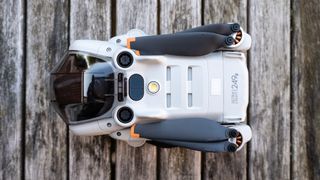
Should you buy the DJI Mini 4 Pro?
If you already own a DJI Mini 3 Pro, you may decide that you can’t justify the upgrade to the Mini 4 Pro. They’re both extremely similar in terms of design and flight, and both use the same sensor. The key differences are the Omnidirectional Obstacle Avoidance, which also delivers a handful of additional features, and several video upgrades. The Mini 4 Pro is undoubtedly the better drone, but it’s not leaps and bounds ahead of its predecessor.
If you’re considering your first DJI Mini-series drone or you’re considering upgrading from an older less-featured drone than the Mini 3 Pro, the Mini 4 Pro is the best sub-250g drone currently available. It’s packed with useful safety features, and image quality for both photos and videos is fantastic for such a small and lightweight drone.
If the DJI Mini 4 Pro isn’t for you
Mini-series drones aren’t the best performers in strong wind, and when it is windy you may find that it’s not safe to take off. So if you’d like a much more powerful drone that’s smaller and lighter than the DJI Mavic 3 series drones, the DJI Air 3 with dual cameras is an excellent choice. This drone features a wide-angle and a medium telephoto camera which both use the same sensor as the Mini 4 Pro, so image quality is comparable.
If you’d like to stick with a sub-250g drone but with a lower price tag, the DJI Mini 3 could be the option for you. It’s not as fully-featured as the Mini 4 Pro and doesn’t offer Obstacle Avoidance, but it uses the same sensor in the camera, which can also be rotated 90 degrees to shoot upright photos and videos.
[ad_2]
